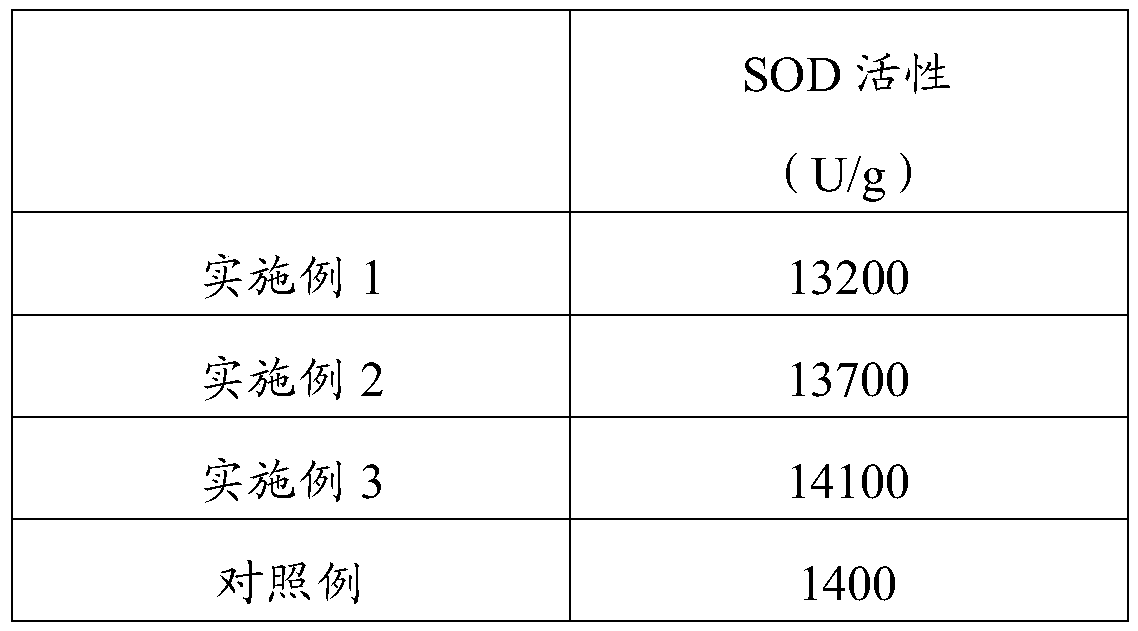Peony ferment for improving and cleaning blood free radicals and production method of peony ferment
A peony enzyme, free radical technology, applied in food science and other directions, can solve the problems of difficult to penetrate the cell membrane smoothly, adverse reactions, low affinity, etc., to achieve the effect of promoting blood circulation, no toxic side effects, and improving metabolism
- Summary
- Abstract
- Description
- Claims
- Application Information
AI Technical Summary
Problems solved by technology
Method used
Image
Examples
Embodiment 1
[0046] The peony enzymes that improve the cleansing of blood free radicals include peony flowers, chamomile, carrots, Pineapple, papaya, tomato, citrus peel, wax gourd, mulberry leaves, fire-acantha, barley, oats, mung beans, grape seeds, and lemons are fermented by adding mixed strains; the mixed strains include a mass ratio of 1:1.5:10.3: 1:0.5:2:0.8 of Bifidobacterium lactis, Aspergillus oryzae, Lactobacillus rhamnosus, Lactobacillus plantarum, Lactobacillus delbrueckii, Hansenula and Kluyveromyces marx.
[0047] The method for improving the production of peony enzymes for cleaning blood free radicals comprises the following steps:
[0048] 1) Raw material selection and cleaning: peony, carrot, pineapple, papaya, tomato, wax gourd, fireacantha, and lemon are selected and then enter the water bath cleaning machine from the conveyor belt. The residual chlorine concentration in the cleaning water is 60ppm, and the cleaning time is 30s;
[0049] 2) raw material pretreatment: c...
Embodiment 2
[0059] The peony enzymes that improve the cleansing of blood free radicals include peony flowers, chamomile, carrots, Pineapple, papaya, tomato, citrus peel, winter melon, mulberry leaves, fire-acantha, barley, oats, mung beans, grape seeds, and lemons are fermented by adding mixed strains; the mixed strains include a mass ratio of 0.5:2:0.5: 2:1:3:1.2 of Bifidobacterium lactis, Aspergillus oryzae, Lactobacillus rhamnosus, Lactobacillus plantarum, Lactobacillus delbrueckii, Hansenula and Kluyveromyces marx.
[0060] The method for improving the production of peony enzymes for cleaning blood free radicals comprises the following steps:
[0061] 1) Raw material selection and cleaning: Peony, carrot, pineapple, papaya, tomato, wax gourd, fireacantha, and lemon are selected and then enter the water bath cleaning machine by the conveyor belt. The residual chlorine concentration of the cleaning water is 80ppm, and the cleaning time is 60s;
[0062] 2) raw material pretreatment: cru...
Embodiment 3
[0073] The peony enzymes that improve the cleaning of blood free radicals include peony flowers, chamomile, carrots, Pineapple, papaya, tomato, citrus peel, wax gourd, mulberry leaves, fireacantha, barley, oats, mung beans, grape seeds, and lemons are fermented by adding mixed strains; the mixed strains include a mass ratio of 0.8:1.8:0.4: 1.5:0.75:2.5:1 Bifidobacterium lactis, Aspergillus oryzae, Lactobacillus rhamnosus, Lactobacillus plantarum, Lactobacillus delbrueckii, Hansenula and Kluyveromyces marx.
[0074] The method for improving the production of peony enzymes for cleaning blood free radicals comprises the following steps:
[0075] 1) Raw material selection and cleaning: Peony, carrot, pineapple, papaya, tomato, wax gourd, fireacantha, and lemon are selected and then enter the water bath cleaning machine by the conveyor belt. The residual chlorine concentration of the cleaning water is 70ppm, and the cleaning time is 40s;
[0076] 2) Pretreatment of raw materials: ...
PUM
 Login to View More
Login to View More Abstract
Description
Claims
Application Information
 Login to View More
Login to View More - R&D
- Intellectual Property
- Life Sciences
- Materials
- Tech Scout
- Unparalleled Data Quality
- Higher Quality Content
- 60% Fewer Hallucinations
Browse by: Latest US Patents, China's latest patents, Technical Efficacy Thesaurus, Application Domain, Technology Topic, Popular Technical Reports.
© 2025 PatSnap. All rights reserved.Legal|Privacy policy|Modern Slavery Act Transparency Statement|Sitemap|About US| Contact US: help@patsnap.com


